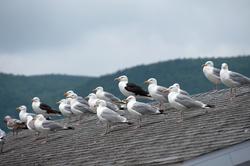 If you own or manage a rooftop nightclub, you know that birds can be a problem. Before you open, these flying pests can leave droppings all over your tables, sofas and chairs, leaving you with a nasty cleanup job. If your club features a pool or spa, bird droppings can pose a real headache, requiring an expensive cleanup. After you open, when guests start streaming in, the presence of birds on tables, chairs and sofas can be a turn off. Birds are attracted to your club because of all the finger foods on tables and scraps that have fallen on the floor. You also need to keep birds away from decorations, signage, bar areas, lighting fixtures and sound equipment. No matter how you look at it, without effective bird deterrents, you’ll be at the mercy of pest birds that can quickly ruin the image of your club. Fortunately, there are some very effective bird deterrents you can install that will keep birds away from your club. Here are three today’s bird control experts recommend: 1. Bird Spikes Proven worldwide, Bird Spikes are the anti-perching, anti-roosting devices that will keep birds off signage, light posts, awnings, fixed umbrellas, rooflines and virtually any elevated structure. Today’s plastic bird spikes come in a rainbow of colors—including crystal clear, brick red, light grey, brown, black and tan—to blend in with your club’s façade. The best plastic bird spikes are made of rigid UV-resistant unbreakable polycarbonate to resist weathering and sun exposure. These spikes come in 3-, 5- and 7-inch widths to protect areas up to 7 inches wide. The base of the spiked strip is just 1.5” wide, so it’s easily installed on narrow fixtures. 2. Bird Chase Super Sonic Easy to set up, the Bird Chase Super Sonic broadcasts predator and distress calls that frighten birds away. The Bird Chase device can be set up to emit distress and predator calls day and night. And it can broadcast distress and predator calls for as many as 22 different types of birds. So one device takes care of all your bird problems. Incidentally, these sounds are not annoying to humans, since they resemble natural birdcalls. And unlike ultrasonic devices, the Bird Chase device emits sounds birds can actually hear. 3. Plastic Bird Netting Easy to install, Plastic Bird Netting can be used to deny pest birds access to overhangs, canopies, and electrical control and food storage areas. Bird netting is available in several mesh sizes to deter various types and sizes of birds. For larger birds, like pigeons or seagulls, a 1-1/8-inch to 2-inch mesh size is recommended; for sparrows or starlings, a 3/4-inch mesh size would do. The best bird netting is UV- stabilized, flame resistant and rot- and water-proof. Bird netting is even available in different colors--like white, stone and black, so it’s barely visible.

Pigeons can create all sorts of annoying problems for today’s property owners. - Pigeons Carry Diseases. These “dirty birds” often gather in huge flocks on buildings. When they do, they pose a threat to human health and safety. Their droppings can carry a virus called encephalitis, which can cause an inflammation of the brain. In fact, they can carry any of 60 known diseases, including salmonellosis and ornithosis, a disease similar to viral pneumonia.
- The Stench & Mess of Droppings. This can negatively impact the appearance of a home or business. The sheer weight of bird droppings has led to the structural collapse of ceilings. The slip-and-trip hazards bird droppings leave on walkways, steps and entrances can be especially dangerous.
- Major Clean-Up Costs. For businesses, this can become a major expense. Removing nesting materials and accumulated droppings can sometimes require specialists in "moon suits" to protect them from disease-carrying clouds of droppings created when hardened droppings are sand blasted away.
- Fire Hazard. Pigeons roosting and nesting near electrical equipment and wiring can create a fire hazard.
Using pellet guns and poisons to get rid of pigeons can be dangerous to pets and children. These measures are also considered inhumane. Egg removal, birth-control pills and food deprivation take three to five years to be effective. Fortunately, there are far more efficient, expedient and humane ways to achieve pigeon control. - Bird Slopes Blend In to Keep Pigeons Out. These angled, slippery PVC panels simply won’t allow pigeons to purchase a landing. Ideal for the many 90-degree nooks and crannies found in most structures, the panels even come in several colors to blend in with a structure’s aesthetics. The best bird slope panels are made of UV-stabilized polycarbonate to last longer in tough outdoor weather.
- Bird Wire Systems Keep Pigeons off Balance. Most birds prefer a stable landing area. Bird wire systems provide anything but that. These post-and-spring-wire set-ups make pigeons “wobble and weave ‘til they leave.” Ideal for railings, rooftops and similar extensions where pigeons prefer to land, wire systems install easily and are often used on Federal and State government buildings. The best bird wire systems feature nylon coated stainless steel wire for lasting durability.
- Bird Spikes Create a No-Landing Zone. Making it virtually impossible for pigeons to land, Bird Spikes come in rigid UV-resistant unbreakable polycarbonate or longer-lasting stainless steel. These pigeon control strips even come in a variety of colors--including white, tan, gray, black, brown, brick red and crystal clear—to make them far less conspicuous. The bird spikes can be easily glued, screwed or nailed to any surface.
- Sonic Repellers Drive Pigeons Away. Pigeons won't nest or roost near the sound of peregrine falcons (a pigeon's dreaded enemy) defending their territory. And that’s exactly what Sonic Bird Deterrents imitate—the sounds of their most fearsome enemy attacking and squawking. Sonic repellers repeat these sounds on a regular basis. And they won’t annoy pets or humans.
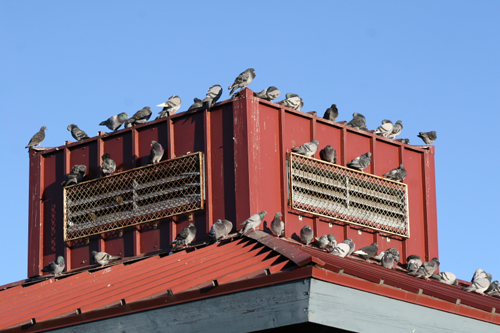
by Alex A. Kecskes
Pigeons are smarter than the average bird. In fact, they're one of the most intelligent birds around. They can recognize their own reflection in a mirror, a feat only 6 species and no other non-mammal can perform. They can also recognize all 26 letters of the English alphabet. They can even differentiate between two different human beings in a photograph when rewarded with food for their efforts. It's no wonder pigeon control has presented such a challenge.
The Days of Shotguns, Cannon and Poisons Are Over
There's a whole new breed of pigeon control solutions. Borne out of society's increasing need to control the damage caused by pigeons, these new devices have proven successful in deterring the winged pests from our homes, boats, parks and commercial buildings. Property owners began to realize that the cute little bird had a nasty habit of pooping all over everything, that these droppings could transmit any of 60 known diseases. And amidst the rising chorus of environmentalist's objections to killing or harming these birds, the mantra of humane deterrent was born.
Spiked No-Landing Zone
Pigeon's fly well but sooner or later, they have to land. And when they do, they don't want to make things complicated. Bird spikes do that. These pigeon control devices have blunted splayed-out spikes that no bird wants to deal with, which makes pigeon spikes both humane and highly effective. Spikes are available in rigid U.V.-resistant unbreakable polycarbonate or high durability stainless steel. You can also get girder spikes, recommended for keeping pigeons off girders or I-beams. Finally, there's the gutter spike, which will keep your rain gutters free of nesting pigeons.
Trap and Release
Here's an effective pigeon control device for those with just a few annoying pigeons. The pigeon motel is basically a live-trap cage that lets you move the offending birds to an out of the way location. These sturdy galvanized wire cages can be used indoors or out. The typical trap will have a funnel trap door that let birds in and an easy access door that lets you get them out.
The Net Result: No Pest Pigeons
Bird netting is an ideal pigeon control solution that relies basically on the barrier method of deterring pest birds. Bird netting has been widely used to keep pigeons from gathering on rooftops, courtyards, patio covers, and other large areas. The best netting is made of ISO 1806 mesh test polyethylene fabric, U.V. stabilized, flame resistant and rot and waterproof.
Pigeons Will Make Tracks…and Leave
Commercial property owners have used electric track devices as an effective pigeon control solution for years. Pigeons are quick to leave after landing on these electrified tracks. One mild jolt of juice is usually all it takes to convince them this is no place to land or nest. Ideal for ledges, signs and other elevated or out-of-reach areas, the tracks install easily and are virtually invisible from below.
Sounds like Pigeon Control to me
Pigeons, all birds, really, are fairly tuned in to sounds around them. Which is what sonic pigeon control devices fully exploit. These nifty devices produce a variety of annoying distress and predator calls. One sonic system emits the distress and predator calls of over 22 types of birds. This includes the sound of Peregrine falcons--a pigeon's worst enemy--defending their territory. The best sonic systems will continually alter the pitch, frequency, timing and intensity of the sounds they emit. Since the sounds are emitted in a random fashion, pigeons are constantly on a state of alert--a condition not conducive to nesting. Sonic bird deterrents are ideal for gardens, rooftops, courtyards, pool areas and other large open areas.
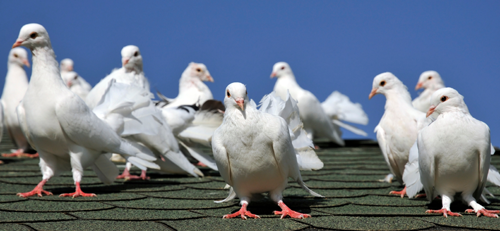
Launceston is a city just north of the state of Tasmania, Australia, at the juncture of the North Esk, South Esk, and Tamar rivers. It is the second largest city in Tasmania with a population of over 100,000 people. The city recently sought advice on how to get rid of pigeons. A recent pigeon plague across inner Launceston rooftops created a smelly mess, cost local businesses thousands and threatened to potentially spread serious diseases.
The pigeons made their nests in some of the city's landmark buildings, including the old gasworks, the Telstra tower, and several of the city's historic banks and government institutions.
Some referred to the putrid pigeon infestation as a major nuisance and potentially toxic. The problem got so bad that one office was forced to close while hundreds of pigeons and their chicks were destroyed as the building's roof cavity was cleared and cleaned. Clearly, something had to be done to get rid of the pigeons.
Business owners noted that the pigeon problem was worse than dealing with rats. People were warned not to feed the pigeons to reduce the amount of droppings, which not only carry disease like salmonellosis, aspergillosis and histoplasmosis, but can create dangerous slip-and-fall liability for a business.
Commercial property owners demanded the problem be addressed. Some businesses had to move into temporary alternative workplaces in remote locales. Other building owners spent thousands removing the pests. The roof of a former bank drew hundreds of pigeons. The bird droppings were knee deep and had to be pumped into a waste disposal truck. To get rid of pigeons, they had to cast a bird net over the entire roof and put up bird spikes.
Bird netting works well to get rid of pigeons. For pigeons, a 1-1/8-inch mesh size is ideal.
When installing netting on rooftops or other outdoor areas, U.V. stabilized, flame resistant and rot- and water-proof netting is best. One brand of bird proof netting currently being marketing is said to be able to withstand severe temperature extremes--from 250-degree Fahrenheit to "sub-zero" temperatures. Non-conductive netting is ideal for installations where electrical conductivity or radio frequency interference could cause problems.
Another way to get rid of pigeons is to use bird spikes. These come in either rigid U.V.-resistant unbreakable polycarbonate or high strength, durable stainless steel. The spikes look threatening, but they won't harm birds or people. They have even been approved by a number of humane groups worldwide--including the U.S. Humane Society and PICAS (Pigeon Control Advisory Service). Bird spikes are available in various sizes and colors. Thee stainless steel spikes come in 3-, 5- and 8-inch widths; their plastic counterparts come in 3-, 5- and 7-inch widths. The plastic spikes are more economical, and they can be used near RF transmission equipment like cell phone antennas because they won't interfere with radiated energy. Bird spikes even come in a variety of colors--like white, tan, gray, black, brown, brick red and crystal clear.

There are about 146,000 retail gas stations and convenience stores in the United States. That's the good news for late-night shoppers and folks running out of gas. The bad news is, many of these stores lack effective pigeon control, which means feral pigeons can pretty much do what they please.
The last thing customers want to touch is a pump handle covered with pigeon poop. Or see the roof or hood of their car splattered with poop when they return with snacks in hand. Theses stores have a pigeon problem because the pesky little birds love to roost in gas station and store canopies. And they do so hundreds at a time.
Without effective pigeon control measures, this often-neglected nuisance can cost commercial property owners thousands of dollars in maintenance and repairs. Keep in mind that just one healthy pigeon creates an average 66 pounds of droppings each year. If you've got a flock of these birds nesting in your gas station canopy, you're looking at several tons of poop over a short period of time.
If you think the damage is all cosmetic, consider what happened to a gas station canopy in Yuma, Arizona. A build-up of pigeon poop clogged up the canopy's drains, causing it to crash to the ground after a heavy rain. A Hummer and a BMW were smashed in the process. Needless to say the gas station owner's insurance policy went up.
Roosting and nesting pigeons can create an unsightly mess on signage, windows and gas pumps. They can clog drains, block out security cameras and jam doors and windows. They can also wreak havoc with rooftop AC units.
As if that weren't enough to implement aggressive pigeon control measures, pigeon droppings are also breeding grounds for a number of diseases. Fecal droppings in pigeon infested canopies can create an environment for bacteria and fungi spores to grow and multiply. This filth can attract mites, black widows, rats, mice and other vermin.
Consider the problems such an environment presents to a gas station that has a full-service food preparation kitchen. If you've got flocks of pigeons gathering on your rooftop or near air induction vents, these air conditioning and air circulation systems could easily suck in pigeon dander, spores and viruses.
Cleaning roofs, parapets, HVAC, ventilation systems and other roosting sites can aerate these areas and increase the risks of exposure to disease. Gas station and store canopies offer the ideal place for pigeons—plenty of food in garbage cans and safe roosting areas.
Failure to implement pigeon control measures can be very expensive in the long run—repairing a canopy can set you back as much as $100,000. And that doesn't include lost sales, city or health violation fees or full canopy replacement.
Some effective pigeon control measures include bird netting, which works to effectively exclude the pests. You can also use chemical fogging systems to drive out entrenched flocks. Both measures are safe to use on pigeons and will save you a lot of grief and expense.

by Alex A. Kecskes
Dozens of filthy pigeons recently invaded the Food Court above the Roma Street Railway Station, creating a health hazard just outside KFC, McDonald's and Donut King. At the Delta Airlines terminal at JFK Airport, pigeons seemed to be everywhere in the food court area, snatching up food and leaving their disease-carrying droppings.
A food court patron in another city accidentally spilled some taco meat on a table and was besieged by a dozen or so pigeons. The filthy birds pulled out all the stops to steal his food. They came out of nowhere, jumping on the table, flying and hovering around him in a panicked effort to devour the precious bits of ground beef. Customers nearby urged him to swat the persistent birds, which he did while trying to hold on to the remains of his taco. The pigeons were extremely aggressive, jumping on and hovering around his hand, pecking at and trying to snatch the taco from his grasp. The determined birds even tried to peck at the taco he was still in the process of chewing. Fortunately, a few solid backhands sent the birds fleeing to another table.
If you’re a food court manager or owner, you can’t afford to have pigeons and other flying pests harassing your customers. Especially in these tough economic times when consumers are cutting back on going out to eat. Pigeons snatching up food from tables and chairs and leaving droppings after they’re done can be a costly health violation. Pest birds, as most health inspectors will tell you, can carry any of 60 known diseases.
To keep pigeons and other pest birds out of food court areas, you must implement an effective bird control strategy. This may involve the use of several bird deterrents to keep persistent birds like pigeons away. Some of the more proven effective bird control measures include:
Pigeon Spikes. These can be placed immediately outside of food court areas to deny pigeons a place to land. If they can’t land, they can’t perch and observe, which is what all pest birds do before they “move in for the kill.” Bird spikes come in rigid U.V.-resistant unbreakable polycarbonate spikes or high-strength, durable stainless steel. You can even order them in different colors--including white, tan, gray, black, brown, brick red and crystal clear to match the décor of your food court. One manufacturer offers a stainless steel spike with a patented “bend-and-crush” design. The best pigeon spikes feature a unique “no-nest” design with no-gap spacing to deter birds from roosting or landing. If your food court has rain gutters outside, these may be infested with pigeon nests. To keep pest birds out of these areas, you’ll need a special kind of bird spike called a Gutter Bird Spike, which is specially designed to fit onto gutters.
No-Knot Bird Netting. Here, again, you want to deny pest birds like pigeons from entering food courts and other areas where food is being prepared or served. This particular netting is low profile, lightweight and easy to handle and install. It comes in several stock sizes and custom cuts. No-Knot bird netting is also tough and resilient with a 10-year guarantee. It’s non-conductive and made of flame resistant, multi-strand polypropylene fiber. (Polypropylene is chemically inert and will resist the influence of many chemicals at ordinary temperatures.) The best bird netting is ISO 1806 Protocol mesh tested. It won’t rot, absorb water, or mildew, and it should have built-in U.V. inhibitors to hold up under years of tough weather.
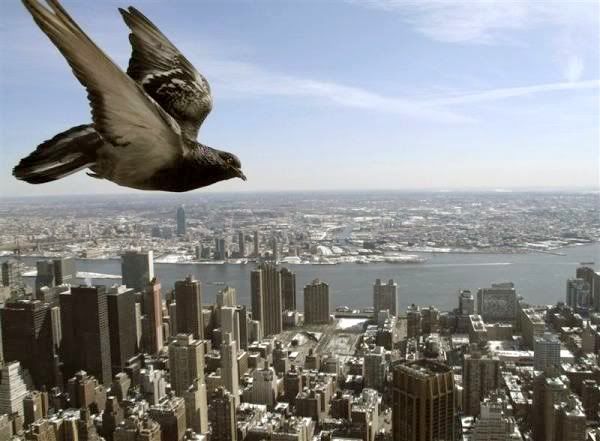
New York City is home to over 1 million pigeons. They mate for life, nest on windowsills, swoop down for scraps of food, and leave droppings on the shoulders of hapless pedestrians. Here, pigeon control is a must.
New Yorkers will tell you that the pigeon problem is everywhere. At brunch style outdoor restaurants, they silently wiggle their way beneath the tables and chairs. One can barely cross his or her legs without the risk of brushing a foot against the filthy birds. They bob and weave and hysterically flap their wings at the slightest irritation. Yes, you can shoo them away with a menu or a napkin, but they come right back. At some restaurants, they've developed the nerve to hop onto empty tables or lounge on the backs of chairs. They've even been known to take food from a child's hand. Without pigeon control, things can get pretty chaotic.
At the Staten Island Ferry Terminal, pigeons have a nasty habit of snatching away breakfasts and defecating on commuters. Urban pigeons dominate city plazas, street-side cafes and monuments. Their droppings plaster Times Square in New York, where they peck endlessly at crumbs or leftover food.
Not helping matters are the people who love to feed the pigeons near commercial food establishments. They draw pigeons to these stores and restaurants creating a nuisance for customers. In some stores, the smells and bacteria from the pigeons are sucked through the ventilation system and can literally cause patrons to leave the store. Pigeon control here is strongly recommended.
Outside, in areas like Times Square and other major intersections, food cart vendors complain of pigeons annoying customers and interfering with business transactions. The smells of pigeons and their droppings near a food cart can be quite overwhelming.
Storeowners in the Big Apple also complain of dead pigeons on sidewalks and entryways to their establishments. Air conditioning units, gutters and downspouts are often clogged with pigeon feathers and nests, causing AC units to jam up and roofs to leak. Pigeon control can save storeowners hundreds, even thousands of dollars.
For commercial property owners who have an occasional pigeon problem or are simply bothered by a few pigeons, a Bird Motel will often suffice. These catch-and-release pigeon control motels are ideal for relocating just a few annoying pigeons. They can be placed virtually anywhere pigeons like to gather. The best motels feature an easy-access door and are constructed of galvanized wire so they won't rust or corrode.
If, on the other hand, you have a store sign or ledge that attracts pigeons by the dozen, you might look into installing some Bird Spikes. The king of pigeon control devices, bird spikes keep virtually any flying pest from landing. To assuage your bird loving customers, they are harmless to birds, pets and people. Spikes come in either rigid U.V.-resistant unbreakable polycarbonate or the longer-lasting, slightly more expensive stainless steel models. You can even get spikes in a variety of colors--including white, tan, gray, black, brown, brick red and crystal clear. The spikes are easily glued or screwed to any surface. The Big Apple is beautiful with the right pigeon control.
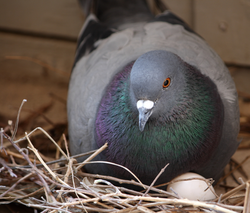 by Alex A. Kecskes
Except for the polar ice caps, the ubiquitous pigeon (sometimes called rock dove) is just about everywhere on the planet. Feral pigeons live in close association with humans, yet they possess the characteristics of highly adapted wild birds. Pigeons typically feed on seeds but they can easily survive on vegetables, meat and other food discarded by humans. Nests are built by the female using material collected by the male.
If you want to keep pigeons from nesting on your property, you’ll have to eliminate their sources of food, water and shelter. When pigeons are on the lookout for places to nest, they’ll first make sure there’s plenty to eat for themselves and their young. If you own or manage a restaurant, particularly, an outdoor eatery, you’ll need to be ever vigilant about food scraps under tables, benches and chairs. The same holds true of dipsy-dumpsters--keep the lids closed and clean up any food around them. Also eliminate any sources of standing water left by sprinklers and maintenance crews.
In terms of shelter, feral pigeons often build their nests in hard-to-reach places, such as covered crevices along building ledges, in the nooks and crannies of building beams and rafters, or in other hidden-away places. Sometimes they’ll use very little nesting material and lay their eggs on bare ground. Nests are usually hard to find and often used over and over. Loose tiles and broken windows will give pigeons easy access to nesting spots. Pigeons are particularly fond of roof spaces, especially those that have open water tanks. In general, gutters, window air conditioners (in particular, empty air conditioner containment boxes), chimney pots and external ledges serve as ideal nesting sites.
by Terra Anders Pigeons, crows, grackles and blackbirds are all well known for their frequent gathering and roosting on rooftops, gutters, air conditioning vents and other structures. This problem affects private homes, public establishments and businesses. Pigeon control is important, not only because of the damage their feces causes to finishes and paint, but also because of the disease that the bacteria and small parasites in their feces may carry. Businesses may find that customers avoid their establishment if these birds are allowed to remain unchecked. These birds do deserve to set down and rest once in awhile, but having them settling in on your property means dealing with quite a mess. Controlling pest birds, like pigeons, does not have to be complicated or harmful to their health. There are several humane bird deterrent methods that can be used quite effectively to send these birds on their way. Any one of these methods can be used without the need for complex or expensive installation. Bird netting can be used when you want to keep birds away from flowers and crops, or from gaining access to any valuable structures. This type of netting is not used to trap the birds, but to keep birds out of a specific area. The most common use of netting is in orchards, vegetable gardens, and vineyards, but it can also be use indoors in larger structures where birds can fly in, and nest up high in the ceiling beams. Most netting is made with knotted strands of plastic cord, and is available in several thicknesses. Lightweight netting is often used indoors to stop bird pests from nesting inside large warehouses, hangers, or tunnels. Heavy-duty bird net is used outdoors, and is designed to resist deterioration in sunlight, rain and extreme heat. It is also available in different widths and lengths. Specially designed plastic clips can be used to attach the netting, preventing damage to the surface being protected. Pigeons, or other bird pests, look for a landing surface that is flat and even. Bird spikes is a method commonly used to deter these birds from roosting on their favorite flat surfaces, such as roofs, ledges, gutters, or signs. These spikes are available in steel or plastic and in many colors, so once installed they are virtually invisible. The spikes are not sharp enough to cause harm, but they are severe enough to create an uncomfortable landing place for winged pests, forcing them to fly onward to find a more suitable area. Another bird control method is an electric bird deterrent system. This system uses a polycarbonate insulator wire embedded in an insulted PVC track that conforms to straight or curved surfaces. They are most effective when laid down over a large, flat area that is likely to invite pigeons or other pest birds to roost. As the bird lands on the unassuming strip, it will receive a light warning shock, causing it to immediately fly away. The shock is not harmful, but it is uncomfortable enough that the pest birds will quickly learn that this is not a suitable landing or nesting spot. This method employs a behavior modification technique that does not interfere with the birds flying patterns, but does change their landing patterns. Controlling pigeon flocks and other feathered friends from becoming damaging pests, is one way to continue to enjoy watching their fanciful flights without the worry of the mess they leave behind. Bird netting, bird spikes and electric bird deterrent systems are all effective and humane choices to consider when deciding which pigeon control methods to use.
 by Fran Prisco Pigeons have become public enemy number one in many large cities. They are in public parks, food courts, and landing or roosting on public buildings. Each year governments and municipalities spend thousands of dollars cleaning up after and repairing damage caused by pigeons. Pigeon droppings are acidic and can damage building materials as well as carry any of 60 different diseases. Bird droppings are also slippery and a big cause of slip and fall accidents on sidewalks and building walkways. It is important that the public feel protected from illness as well as physical harm when using public facilities. To get rid of pigeons from public areas, the pigeon spike is the answer. Pigeon spikes keep pest pigeons from landing and roosting on flat and curved surfaces such as roof ledges, windowsills even channel letters. The best pigeon spikes come are made from polycarbonate plastic with built in U.V. protectors for long life. They are manufactured in two-foot sections for easy and quick installation. Installing Pigeon Spikes Before installing any type of bird control product or system, it is important to do a thorough clean up. All debris and droppings left behind by the birds must be removed. It may be necessary to power wash the area to remove bird droppings and other debris before installing the pigeon spikes. A clean surface is needed in order for the spikes to adhere to the surface being treated when installing with adhesive. Pigeon spikes are easily installed using glue, screws or tie downs. When using glue, choose a construction grade adhesive that will keep the spikes in place regardless of weather or temperatures. It is important that the entire surface be covered with the spikes. If there is space of more than an inch in front of or behind the spikes, pigeons will be able to land and use the spikes to drop nesting materials and make nests. Once installed the pigeon spikes are virtually invisible and will not take away from the building aesthetics. Pigeon spikes are practically maintenance free. It is a good idea to inspect the spikes periodically to be sure there is not a build up of leaves or twigs in the spikes, or that they have not come loose. Related articles 
|











 RSS Feed
RSS Feed